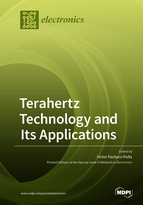Terahertz Technology and Its Applications
A special issue of Electronics (ISSN 2079-9292). This special issue belongs to the section "Microwave and Wireless Communications".
Deadline for manuscript submissions: closed (15 October 2020) | Viewed by 43032
Special Issue Editor
Interests: terahertz; antennas; lenses; sensors; metamaterials; metasurfaces; 2D materials; imaging systems; wave–matter interaction
Special Issues, Collections and Topics in MDPI journals
Special Issue Information
Dear Colleagues,
The Terahertz frequency range (0.1 – 10)THz falls has demonstrated to provide many opportunities in different fields, such as high-speed communications, biomedicine, sensing, and imaging. This frequency range, lying between the fields of electronics and photonics, has been historically known as “terahertz gap” because of the lack of experimental as well as fabrication technologies. However, many efforts are now being carried out worldwide in order improve technology working at this frequency range. Within this context, the aim of this Special Issue is to provide a mechanism to highlight the work being done within this range of the electromagnetic spectrum. The topics covered (but not limited to) within this Special Issue are the following:
- terahertz metamaterials and metasurfaces;
- terahertz antennas;
- sensing at terahertz frequencies;
- non-destructive testing;
- terahertz imaging and its applications;
- terahertz spectroscopy;
- communication systems at terahertz;
- advanced terahertz materials;
- plasmonics
Dr. Victor Pacheco-Peña
Guest Editor
Manuscript Submission Information
Manuscripts should be submitted online at www.mdpi.com by registering and logging in to this website. Once you are registered, click here to go to the submission form. Manuscripts can be submitted until the deadline. All submissions that pass pre-check are peer-reviewed. Accepted papers will be published continuously in the journal (as soon as accepted) and will be listed together on the special issue website. Research articles, review articles as well as short communications are invited. For planned papers, a title and short abstract (about 100 words) can be sent to the Editorial Office for announcement on this website.
Submitted manuscripts should not have been published previously, nor be under consideration for publication elsewhere (except conference proceedings papers). All manuscripts are thoroughly refereed through a single-blind peer-review process. A guide for authors and other relevant information for submission of manuscripts is available on the Instructions for Authors page. Electronics is an international peer-reviewed open access semimonthly journal published by MDPI.
Please visit the Instructions for Authors page before submitting a manuscript. The Article Processing Charge (APC) for publication in this open access journal is 2400 CHF (Swiss Francs). Submitted papers should be well formatted and use good English. Authors may use MDPI's English editing service prior to publication or during author revisions.






